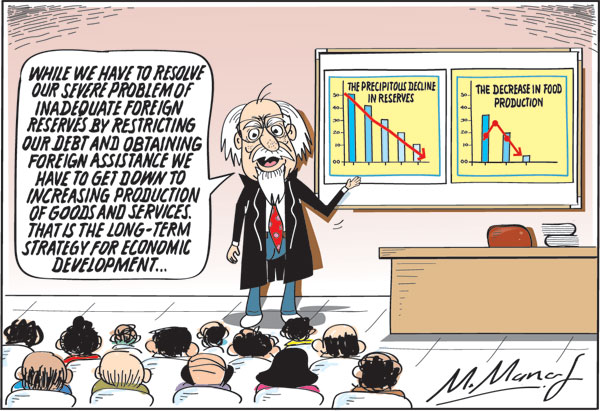Columns
Resolving the foreign reserves crisis and increasing production
View(s): The current focus is on resolving the crisis in foreign reserves. Resolving the inadequacy of external reserves to meet international debt repayment obligations and essential import needs is of utmost urgency. However, the way forward for the country is by increasing the production of goods and services for domestic consumption and exports.
The current focus is on resolving the crisis in foreign reserves. Resolving the inadequacy of external reserves to meet international debt repayment obligations and essential import needs is of utmost urgency. However, the way forward for the country is by increasing the production of goods and services for domestic consumption and exports.
Increasing production
This fundamental fact has been neglected. This is especially so with respect to agriculture where there have been impractical policies and inadequate investment in research and efforts for the adoption of high yielding technology for increasing productivity of crops. Similarly, there have been setbacks to manufacturing owing to difficulties in obtaining raw materials and high import tariffs costs of manufactures are high.
External finances
No doubt, the country’s dwindling external reserves reaching near bankruptcy is the most serious problem. Therefore, the current preoccupation on the economy has been on the country’s inadequate foreign reserves and the related issue of severe economic hardships faced by the people. This focus on the economy is understandable, and in fact, inevitable. However, this preoccupation has led to a lack of focus on the need to increase the country’s production of goods and services which isneeded to resolve the economic crisis.
Decreased agricultural production
The country is in the unenviable position of a decreased output in agriculture and lower availability of, and soaring prices of food. There is an imminent prospect of food production decreasing in the first half of the year. This is especially so with respect to the Maha paddy output.
Officials who said this have lost their positions. Those who wish to safeguard their jobs have said food production will not decrease by much. The crop production statistics this year are likely to be inflated and unreliable. The availability of rice and the prices of it would be the best indicator of this fall in production.
Maha 21/22
This year’s Maha paddy production is likely to be at least 30 percent lower than Maha 20/21. This drop in paddy production will hopefully be offset to some extent by a revival in Yala.
The availability of fertiliser and agrochemicals and favourable weather would be determining factors. Similarly, the reduced production of other food crops must be speedily restored by the availability of fertiliser and weedicides. Agricultural policies have unnecessarily undermined the country’s production capacity and aggravated external financial difficulties.
Tea production
Tea production is expected to decline by five percent this year owing to the unavailability of fertiliser. This decrease is mainly from smallholdings that produce the bulk of tea (80 percent).
Tea exports that increased in 2021, are likely to decline this year owing to reduced production. The Tea Small Holders Association (TSHDA) would have to play a more proactive role in ensuring credit and inputs to growers.
Other crops
Other crops too have faced severe setbacks owing to the unavailability of chemical fertiliser and agrochemicals. Besides this, there has been a lack of a plan for agricultural development. Even where there has been one, as in the case of the Rubber Master Plan, implementation has been tardy owing to inadequate resources. The research institutes have been starved of funds and their technical capacities weakened.
Implication
The country needs a serious look at agriculture and a long-term plan for increasing agricultural production. Considerably more resources and thought need to be given to resuscitate agriculture.
Exports
Although the trade deficit widened last year, exports performed well. There was a significant export growth over the export earnings of 2020. This increase in export momentum accelerated after June to monthly export earnings of more than one million US dollars in the second half of the year.The continuation of this growth is imperative to reduce this year’s trade deficit and improve the balance of payments.
Raw materials
However, there are two downside risks. There should be no shortages of raw materials for export industries. The government must ensure that there are no ‘bottlenecks’ and difficulties in obtaining essential raw materials. The required imports of raw materials for our manufactured exports are about two-thirds of their export values. The credit lines obtained from China and India must be used for obtaining raw materials for manufactured products.
Agricultural exports
Where agricultural exports are concerned their dependence on imports is only about 25 to 30 percent. This also implies that agricultural exports are more important than the relative export earnings of manufactured and agricultural exports indicate. Therefore, it is crucial that imports of fertiliser and agrochemicals are available. This is especially so for tea cultivation. The recent ban and shortages of fertiliser and weedicides may affect this year’s export surpluses of tea, in particular.
The constraint to increasing agricultural export earnings is their supply limitations. This is so with respect to a wide range of the country’s exports of pepper, cashew and spice crops. The implementation of policies to remove these constraints is vital to increase export earnings and supplies for domestic consumption.
Summary and conclusion
The critical state of the country’s foreign reserves aside, the foremost reason that has caused severe hardships for people is the essential goods of cooking gas, kerosene, powdered milkand other products not being available. Now with the availability of wheat flour, electricity, and petrol threatened, the Government’s focus should be in resolving this grave crisis. Yet it must focus its attention on increasing the domestic production of goods and services to resolve this problem in the long run.
We have to resolve our severe crisis in foreign reserves by restructuring our debt and obtaining foreign assistance. The credit lines from China and India will be useful in meeting the essential requirements of food products, pharmaceuticals and fuel, but inadequate to meet the other needs of the country.
It is essential that the country gets down to increasing the production of goods and services. That is the long-term strategy for averting crises and achieving economic development.
Priority should be given to reviving agriculture by making chemical fertiliser and agrochemicals widely available. However, a long-term strategy to increase the production and productivity of crops must be put in place quickly.
The future of the country rests on increasing the agricultural output by removing recent constraints, by expanding the cultivated areas of some crops including rubber and increasing productivity overall.
Buying or selling electronics has never been easier with the help of Hitad.lk! We, at Hitad.lk, hear your needs and endeavour to provide you with the perfect listings of electronics; because we have listings for nearly anything! Search for your favourite electronic items for sale on Hitad.lk today!


Leave a Reply
Post Comment